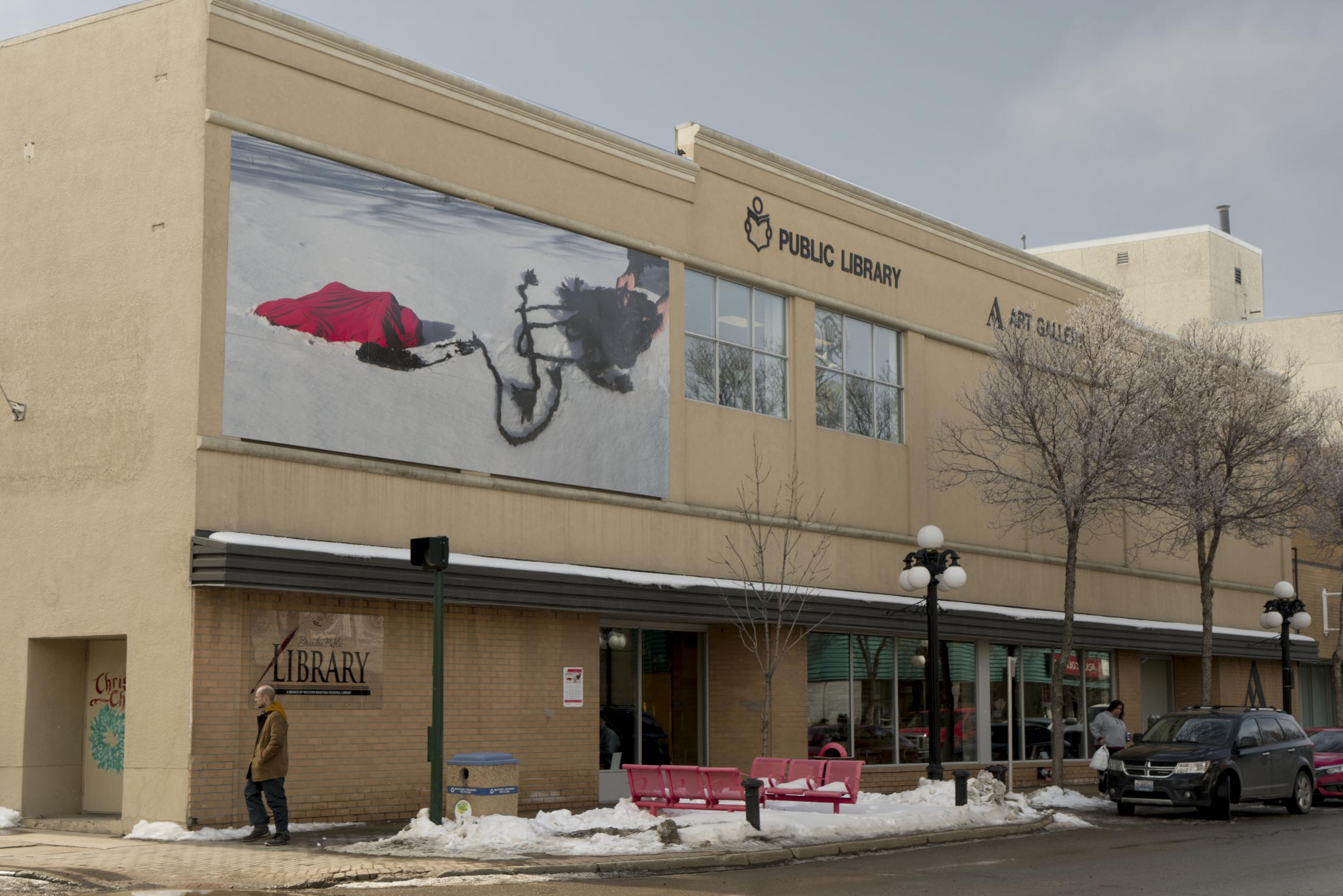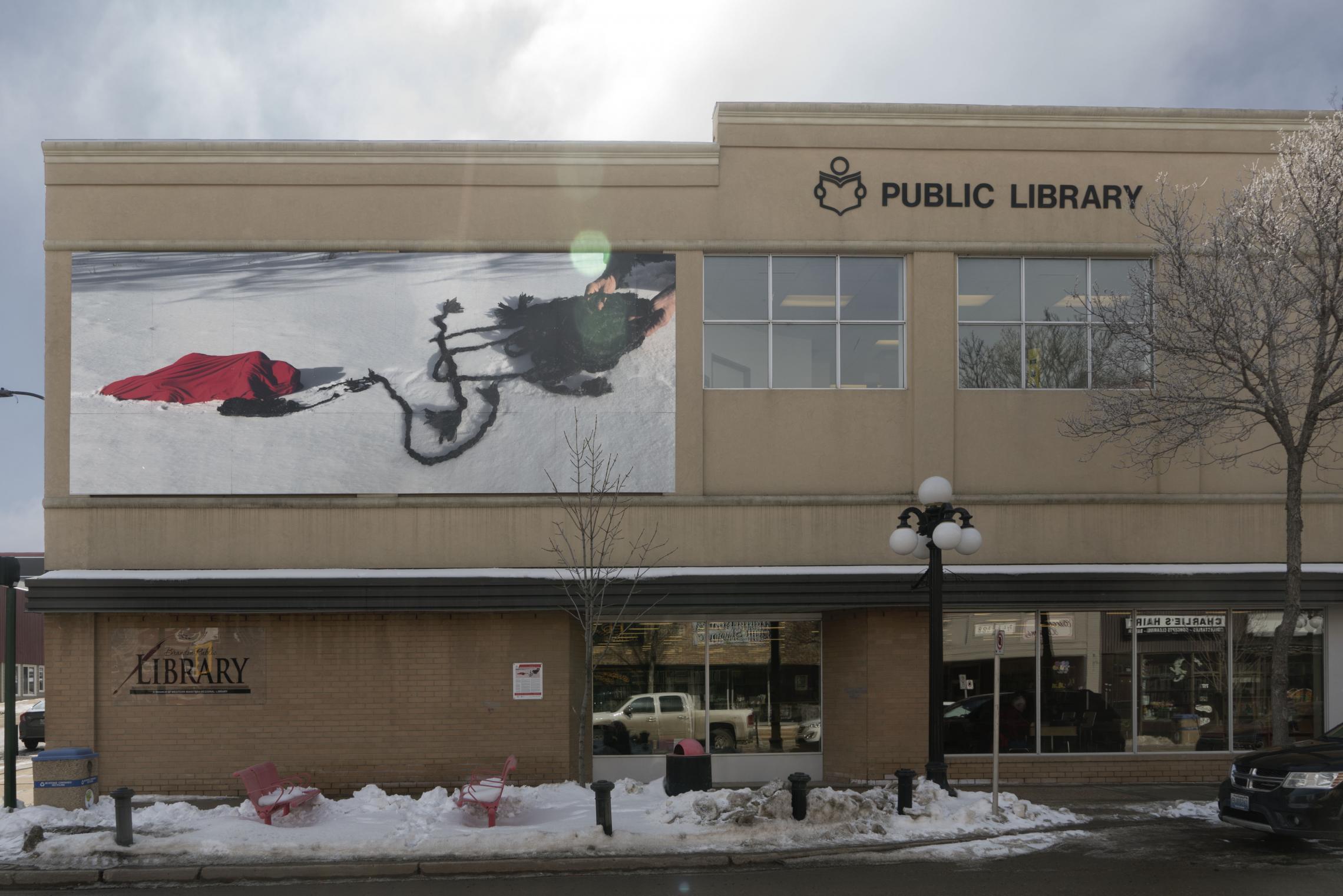JAIME BLACK WITH BARBARA BLIND AND JESSIE JANNUSKA
Events
Launch and Reception: Thursday March 22, 7:30PM
Photographed on the site of the former Brandon Indian Residential School, "She gathers" honours the school’s former students and the many people in this region who have helped rebuild Indigenous communities, culture, and identity since its closure.
Lying in the snow, the artist’s body is draped in red cloth, among a pile of cut braids that are being gathered by the hands of a local elder. The body of the artist stands in for all those who were lost to their families and communities at these residential schools—a loss that is still felt today with each missing or murdered Indigenous child in Manitoba and across Canada.
These cut braids act as a symbol of grief—for the loss of both life and culture experienced through the Residential School system. For many people Indigenous to this land, the braid is a symbol of identity, strength, and the wisdom of ancestors. The braid often represents one's connection to land and tradition; it is braided by loved ones who send love, prayers, and good intentions into the hair as they work. On the plains, it is a common custom to only cut one’s hair while grieving the loss of a loved one.
Despite this importance, when a student arrived on their first day at a Residential School in Canada, their hair was cut—marking the child’s removal from their family, history, and tradition—and they were no longer allowed to speak their language nor practice their culture. Following Canada’s official assimilationist policy towards Indigenous people’s, the Residential School System was an agent of cultural genocide meant to eliminate the existence of an entire race through the theft—and social engineering—of their children; infamously described at the time as “killing the Indian in the child.”
Yet Indigenous people and culture persevere. Brandon has many strong Dakota, Anishinaabe, Mètis, and other Indigenous leaders, who gather knowledge that was stripped away in these schools. They keep the culture, and their people alive, as they find healthy ways to walk the earth today. The trauma of this period still weighs heavy, but "She gathers" honours the knowledge keepers, women, youth, and others, whose strength lifts up Indigenous peoples across this region. It is a recognition of a difficult history, while acknowledging the work communities are doing to gather and recollect their cultural and spiritual knowledge, to heal from trauma and create a better present and future built on respect and care.
About Brandon Indian Residential School
Brandon Indian Residential School (also known as Brandon Industrial School) was open between 1895–1972. At least 70 children died while attending the school, with many more yet to be identified. These children are buried in mostly unmarked graves across its former. grounds. Only eleven are named in the school’s cemetery.
In 1969 the school ceased to oer classes and simply operated as a residence managed by the federal government until its closure in 1972. In 2000 it was torn down. The site of the former school is owned by the Sioux Valley Dakota Nation; it sits on the northwest end of town, north of Turtle Crossing Campground.
Despite protests, the school was erected far away from the communities of most of its students, with hopes that the close proximity to a settler community would—in the words of then Indian Affairs Commissioner, Hayter Reed—“assimilate them with the white population, and save them from relapsing into ignorance and barbarianism” (Nichols, Katherine. “Investigation of Unmarked Graves and Burial Grounds at the Brandon Indian Residential School,” University of Manitoba, 2015). City leaders at the time, lobbied in favour of building the school in Brandon, offering the site for free in exchange for equivalent lands granted by the federal government.
The school often struggled with low enrollment, so at times it admitted non-status Indians and students from Saskatchewan, Alberta, Ontario, and Quebec. Until 1956, the school specialized in agricultural training. Male students spent much of their day working the fields—a primary source of revenue beyond the federal funding offered for each student. Female students worked as domestic helpers. At the height of its operation in 1931, the school owned 960 acres of farmland.
During its first sixty years, the school often struggled with malnutrition, disease, loss of limbs from farming accidents, and abusive physical and mental disciplinary regimes. In its final years,
there were less reports of such severe problems, perhaps due to changing social norms, and reforms put in place by less disciplinarian principals. In the testimony given by former students about their experiences at the school, you will hear about some of the many hardships, as well as the good times, and its positive influence teaching, reading, writing, and work ethic.
About this billboard
The Art Gallery of Southwestern Manitoba Billboard is a new exhibition space that showcases work by Indigenous artists. From July 2017–June 2019, the AGSM Billboard will exhibit a total of four site-specific images that celebrate the presence and importance of Indigenous culture to Brandon and the Westman region—in the past, present, and future.
About the Artists
Jaime Black is a Métis multidisciplinary artist originally from Thunder Bay, Ontario. Her work engages in themes of memory, trauma, resistance, and resilience. Largely self taught, Black began a full time arts practice after creating The REDress Project, an installation art project that draws attention to missing or murdered Indigenous women and girls.
Barbara Blind is an Anishinaabe Kwe from George Gordon First Nation in Saskatchewan, currently living in Brandon, MB. She is the knowledge keeper of Ishkabatens Waasa Gaa Inaabateg (Brandon University's Department of Visual and Aboriginal Art).
Jessie Jannuska is a Brandon-based visual artist with Dakota, Ojibway, and European ancestry. She is in the final year of her degree at Brandon University, pursuing a Bachelor of Fine Arts with honours. Jannuska works in oil, acrylic, watercolor, pencil, pen, beading, and installation.
Site of the former Brandon Indian Residential School:
More information:
Truth and Reconcilliation Commission of Canada's reports and findings
Katherine Lyndsay Nichols, "Investigation of unmarked graves and burial grounds at the Brandon Indian Residential School" (includes a list of name of all children known to have been buried at Brandon Indian Residential School)
United Church of Canada Residential School Archive Project entre on Brandon Indutrial Institute
This text was written by John G. Hampton with the input of the artists and community collaborators, and with summarized research drawn from the Truth and Reconciliation Commission of Canada, and Katherine Nichols’ 2015 thesis, “Investigation of Unmarked Graves and Burial Grounds at the Brandon Indian Residential School.”
The AGSM Billboard Advisory circle provides guidance and feedback throughout the production and planning process and is comprised of: Peter Morin, Jason Gobeil, Leah Laplante, Lisa Wood, Chris Reid, Roberta MacKinnon, and Debbie Huntinghawk.
A special thank you to Shannon Guimond, and Savannah Thomas for their assistance on this project.
Support for this project has been provided by The Whitehead Foundation For Western Manitoba Inc; the RBC Emerging Artists Project; and the Community Fund for Canada’s 150th, a collaboration between the Brandon Area Community Foundation, the Government of Canada, and extraordinary leaders from coast to coast to coast.


